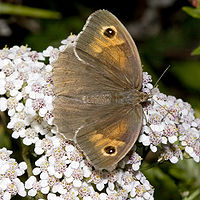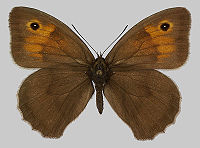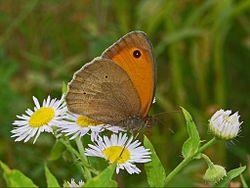- Meadow Brown
-
Meadow Brown 
Female 
Mounted Scientific classification Kingdom: Animalia Phylum: Arthropoda Class: Insecta Order: Lepidoptera Family: Nymphalidae Genus: Maniola Species: M. jurtina Binomial name Maniola jurtina
(Linnaeus, 1758)The Meadow Brown, Maniola jurtina, is a butterfly found in European meadows, where its larvae feed on grasses, such as Sheep's Fescue.
Similar species are Gatekeeper (which prefers to rest with its wings open) and Small Heath (which is smaller).
There is marked sexual dimorphism in this species. Males are less colorful, with smaller eyespots and much reduced orange areas on the upper forewings. They are also much more active and range far about, while females fly less and often may not away from the area where they grew up.
A variable number of smaller eyespots are usually found on the hindwing undersides. These may number up to 12 per individual butterfly, with up to 6 on each wing. The factors that govern polymorphism in this trait are not resolved, although a number of theories have been proposed (Stevens 2005). On the other hand, the evolutionary significance of the upperwing eyespots is more obvious: The more active males have a markedly more cryptic upperside pattern, whereas the females have more often opportunity to present their eyespots in a sudden display of colors and patterns that presumably make neophobic predators hesitate so that the butterfly has better chances of escaping.
Food plants
Rough Meadow Grass Poa trivialis, Smooth Meadow Grass Poa pratensis
References
- Stevens, Martin (2005): The role of eyespots as anti-predator mechanisms, principally demonstrated in the Lepidoptera. Biol. Rev. 80(4): 573–588. doi:10.1017/S1464793105006810 (HTML abstract)

This Satyrinae article is a stub. You can help Wikipedia by expanding it.


